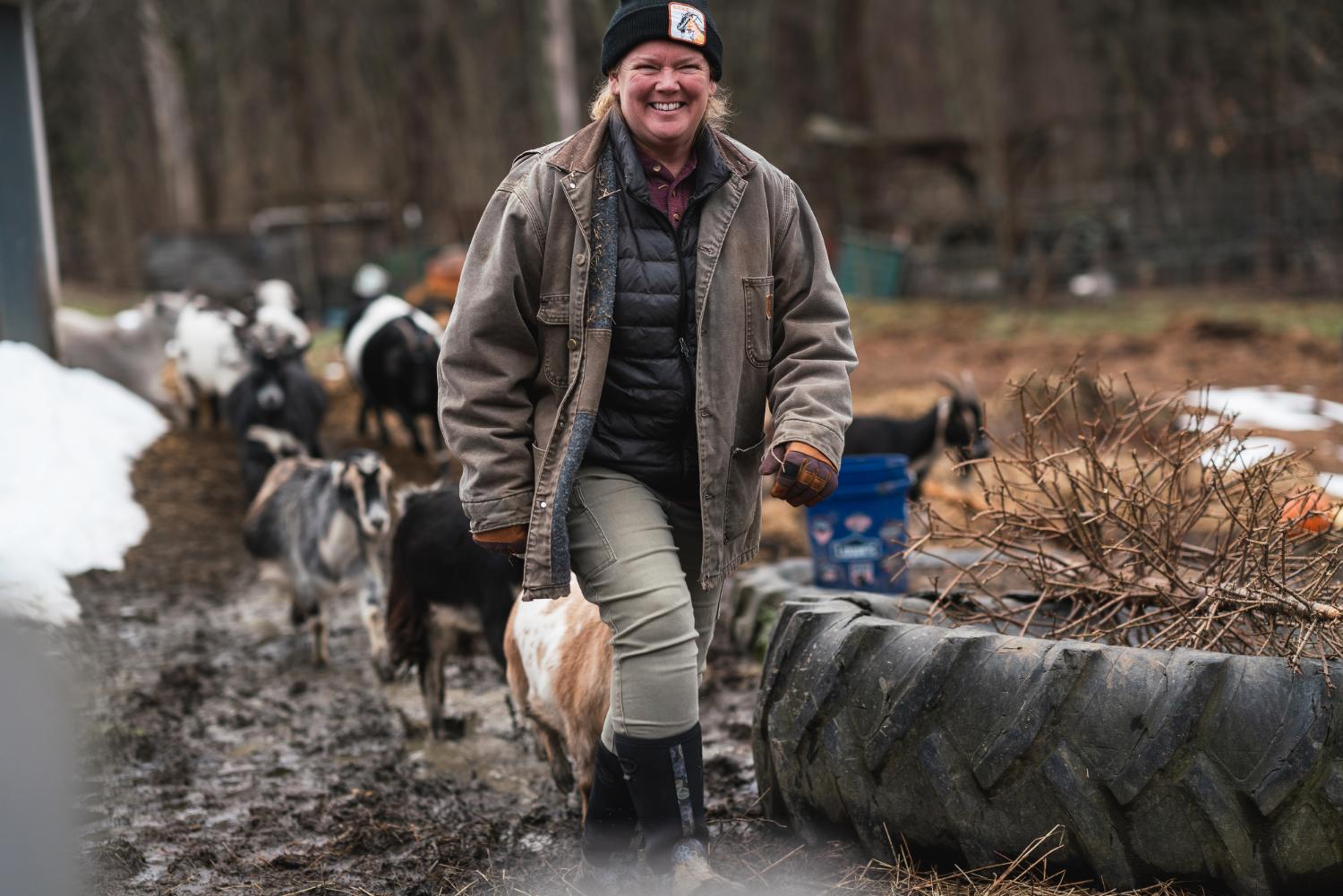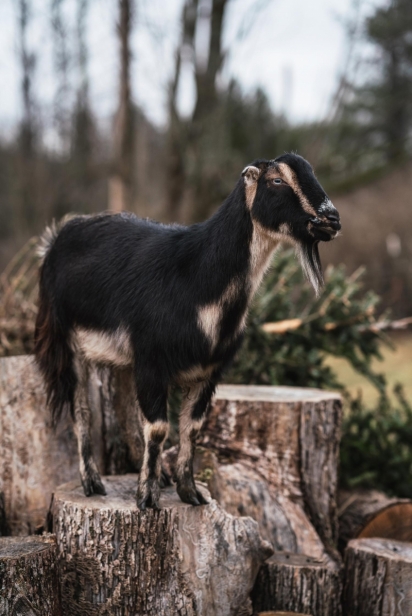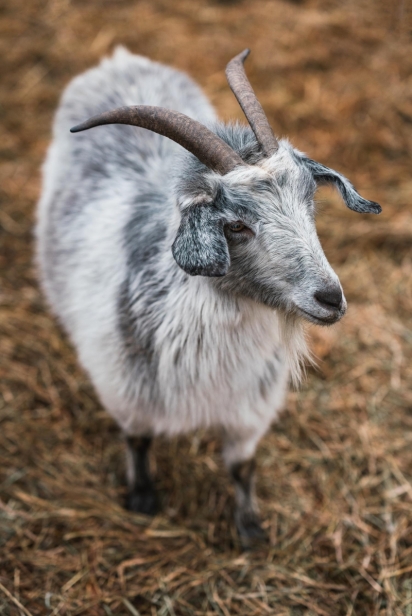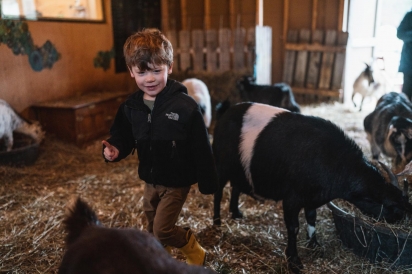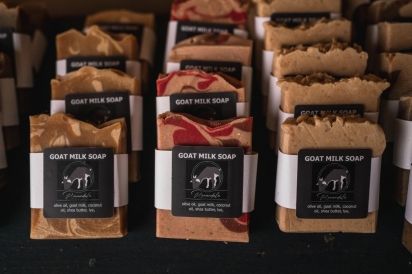Rowandale Goat Farm
Alice Clarkson grew up in the city but knew she was destined to live on a farm. She also wanted to be a chef, a desire rooted in memories of hiding with her brother under the tables of restaurants her mother owned in London, Ontario, Canada.
She recalls that over her 20-year career as a chef, her most innovative moments occurred while she was preparing vegetables.
“I gravitate toward colorful, beautiful vegetables that are uncommon in some way,” Clarkson says. “The flavor profile: from earthy to bright and fruity, has always interested me. It’s the same with cheese—finding that perfect blend of sweetness and sharpness.”
One day, Clarkson set out to find a better-tasting goat cheese. When she couldn’t find one that she liked, she bought a couple goats: Annie and Abby. She soon discovered that there was much more to goats than milk and cheese and began to understand how special goats truly are.
Clarkson turned her passion for food and farm living into what today is called Rowandale Farm, home to a herd of mini LaMancha goats that she raises as therapy animals. While raising her goats, she also discovered the key to delicious goat cheese.
Before owning the farm, Clarkson spent time around animals when studying equine science at an agricultural college in northern Ontario. She moved to Buffalo for work and met her husband, Richard, a pastor, whom Clarkson calls her dream-fulfiller.
After they were married, they bought Richard’s grandmother’s farm, 25 miles southeast of Buffalo. There, Clarkson learned that Richard’s grandmother raised nine children on the farm, and everyone drank goat milk.
When a friend gifted Clarkson a full-sized LaMancha goat, she noticed how gentle and calm the breed was. And soon she wanted more.
“The minis on our farm are a cross between Nigerian dwarf goats and full-sized LaManchas,” she says. “We chose this breed for temperament and personality. I lease a sire for six weeks each year to impregnate the moms. Five months later, the babies arrive.”
The idea of using her goats as therapy animals came to Clarkson after she witnessed how a boy who was nonverbal opened up while visiting one of the herd.
The use of animals as a way to help people cope with or recover from either physical or mental illness has become more popular in recent years. Animal or pet therapy builds on the concept of a human-animal bond: a person’s desire to interact with or relate to animals, which can induce a calming effect.
The Association of Animal-Assisted Intervention Professionals (AAAIP) believes that therapy animals are sentient beings that express preferences. Their goal is to integrate the use of animals in therapeutic practice by identifying individuals who might be suited to this type of approach.
Clarkson says a broad cross-section of people schedule therapy sessions with her goats.
“We have veterans with PTSD, children with special needs, and elderly people with dementia who come to the farm to enjoy goat therapy.”
Therapy sessions on the farm are self-guided—and free. Clarkson says a session starts with smell: the scent of hay and animals, which she describes as a subtle, spicy aroma. There are benches, blankets and chairs spread around for guests to settle in and get comfortable.
According to Clarkson, a goat will match itself to a person for a therapy session.
“For example, Clark, a male goat, is most empathetic toward men who are veterans and those with PTSD. When small children visit, some of whom might be fearful at first, ever so gentle Misty and Miso are there to greet them.”
If a group arrives, Clarkson will put a few of her goats on leashes so visitors have a chance to get to know them at their own pace.
“Being in the presence of these loving creatures is just a part of the experience,” she explains. “Sometimes people enjoy brushing a goat during a session. There is no wrong way to participate in a therapy session here.”
According to Clarkson, the most joyous time to visit Rowandale Farm is when the baby goats are born.
“We invite anyone who wants to come to witness the births. I have yet to miss one. I’m there before the babies are cleaned off. We train the babies to come into our arms from the very first moment they are born. We hold them every day from birth to allow them to adjust to human touch.”
Clarkson also invites people to come out to the farm to cuddle her baby goats. “We need lots of welcoming arms,” she says.
Volunteers are recruited to cuddle on Wednesday evenings after birthing season. And there is no shortage of willing participants.
This early training, according to Clarkson, results in the calmest, most gentle animals that seem to love being with people and are therefore well suited to serve as therapy animals.
“Be prepared for the herd to walk right up to you to greet you when you arrive,” says Clarkson.
The farm welcomes anyone who needs some alone time with a tender, attentive animal. She suggests participants wear old shoes and clothes they don’t mind getting dirty because her goats like to have fun.
Introducing her goats to visitors is all about forming connections for Clarkson, who believes connection is one thing that’s lacking in today’s world. She says that goats are under-utilized in the U.S. compared to the rest of the world and they produce delicious, healthy milk.
And the key to delectable goat cheese, according to Clarkson, is to “keep the boys off the farm.” Male goats have a strong odor that may transfer to the female goats and affect the taste of their milk.
“When you are a chef, you taste to compare flavors. What I discovered on my farm was that milk from my mama goats was richer and sweeter to the taste because it had a higher butterfat content. More butterfat makes a creamier goat cheese.”
Clarkson explains that making goat cheese from milk is a simple process. “Start with the perfect high fat goat milk. Add an acid like rennet, apple cider vinegar, or lemon juice. Let the milk sit at room temperature overnight. The curd will separate from the whey. Discard or store the whey and enjoy.”
Clarkson makes flavored cheeses for family and friends like her lemon basil goat cheese.
Though Rowandale Farm is not a certified dairy and cannot sell milk and cheese, Clarkson’s goats produce enough milk to supply her family with plenty of both.
Goat milk is also the main ingredient in the goat milk soaps Clarkson makes and sells on her farm. Clarkson says her soapmaking has redirected her creativity, once devoted to preparing food, exclusively to making goat milk soaps from natural ingredients such as olive oil, coconut oil and yes, goat milk.
“Working as a chef has made me an excellent farmer. Taking ingredients from the earth, from the farm, and turning them into something beautiful, has given me a new respect for where food comes from. As for the goats—well, they’re pure joy.”


